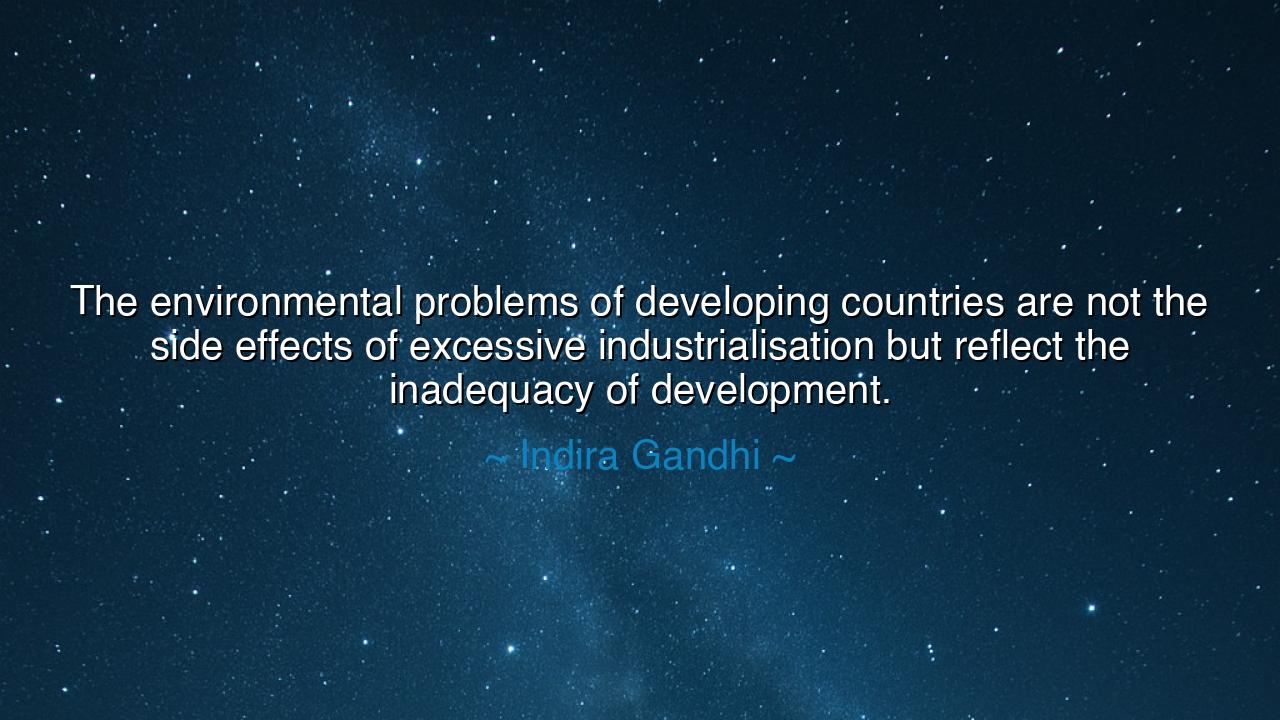
The environmental problems of developing countries are not the
The environmental problems of developing countries are not the side effects of excessive industrialisation but reflect the inadequacy of development.






In the councils of elders, where wisdom is weighed against the grain of the real, a hard saying is sometimes the most merciful. Indira Gandhi’s declaration—“The environmental problems of developing countries are not the side effects of excessive industrialisation but reflect the inadequacy of development.”—names a truth often missed by distant observers: that smoke and sewage, eroded hillsides and poisoned wells, are not chiefly symptoms of “too much growth,” but of too little of the right kind—too little sanitation, education, public health, steady work, and accountable institutions. She spoke these words to the world at the 1972 UN Conference on the Human Environment in Stockholm, a stage on which she also pressed the companion insight, remembered as “poverty is the worst form of pollution.”
Hear the structure in her sentence: it is not an excuse for exploitation, but an argument about sequence. Without clean water systems, garbage collection, safe cooking fuels, reliable transit, and decent housing, the poor must survive by stripping what lies closest—forests for charcoal, rivers for washing, empty lots for refuse. Thus inadequacy of development breeds the very scars that outsiders later blame on “industrial excess.” Gandhi’s point, made before the vocabulary of “sustainable development” was common, was that just and adequate development—primary care, civic services, fair opportunity—can be medicine for both people and place.
Consider a parable drawn from many towns: where families cook on smoky stoves because clean fuels are absent, lungs are blackened and ceilings are tarred; where latrines and sewers are few, cholera follows the rains; where municipal budgets are thin, dumping grounds creep toward homes. None of this requires a steel mill; it requires lack—of pipes, clinics, technicians, trust. Strengthen those sinews and the air clears, the river sweetens, the hillside holds. Gandhi’s claim is not romance but accounting: count clinics and taps, not only chimneys, and the pattern becomes plain.
Her message also answered a politics of blame. In Stockholm, many in wealthier capitals spoke as if “development” itself were the villain—as if the South should accept permanent scarcity to keep the global garden tidy. Gandhi refused this bargain. She argued that for the poor, development—done wisely—is not an enemy of the environment but its ally: it is what brings food, water, sanitation, and shelter, “making the deserts green and the mountains habitable.” In other words, the cure for a sickness caused by inadequacy is not abstinence from dignity but investments that let dignity take root.
History bears witness. Where cities have paired rising incomes with basic services—mass vaccination, storm drains, waste removal, clean energy for cooking—the local environment often recovers alongside human health. The lesson harmonizes with Gandhi’s later-remembered refrain: address poverty and you address a primary driver of environmental harm; neglect it and you harden the harm into habit. Thus the moral arithmetic of Stockholm: if you would save forests, save families; if you would heal rivers, heal neighborhoods; if you would cool the climate, warm the lives of those who have been left in cold shadow.
From her saying, take this law: plan in the order that life demands. First, secure adequate development—clean water, clean kitchens, safe streets, schooling, clinics, and the steady work that lets people choose long-term over desperate short-term. Next, guide industry by standards that protect air and water, so that prosperity does not purchase ruin. Finally, build the civic muscle—transparency, enforcement, participation—without which even good plans dissolve. Done in this sequence, growth becomes a gardener; reversed, it becomes a grazer.
Let counsel become action. For leaders: budget first for basic services in the poorest wards; tie every infrastructure dollar to measurable environmental gains (fewer asthma visits, cleaner drains, cooler streets). For planners: design “triple wins” where a single investment lifts livelihoods, land, and health—for example, programs that replace smoky stoves with clean fuel while creating local jobs to maintain them. For communities and allies: measure what matters (child height, waterborne disease, tree canopy, household fuel use), not just what is easy to count. And for all who listen: resist false choices. The choice is not between development and the environment; as Gandhi taught, the right choice is development that repairs, so that people and planet rise together.






AAdministratorAdministrator
Welcome, honored guests. Please leave a comment, we will respond soon